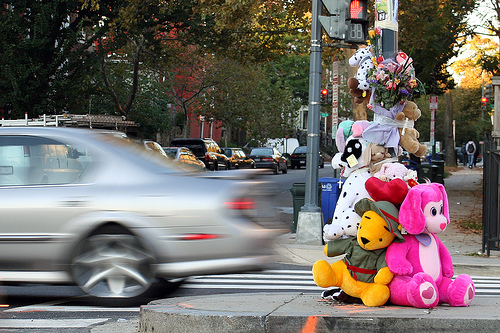
Photo credit: IntangibleArts
The latest Department for Transport road casualty statistics show a decrease of 2 per cent compared with 2012.
This is the lowest figure since national records began in 1926.
- In 2013, 1,713 people were killed in road accidents, the lowest number on record, and half as many as in 2000.
- In 2013, 21,657 people were seriously injured in road accidents.
- The total number of casualties of all severities in 2013 was 183,670.
- Car occupant fatalities in 2013 decreased to 785, down 2 per cent compared with 2012 and 44 per cent compared with the 2005-2009 average.
- There were 398 pedestrian deaths, 5 per cent fewer than in 2012.
- The number of pedal cyclists killed decreased by 8 per cent from 118 in 2012 to 109 in 2013.
- The number of motorcycle users killed increased by 1 per cent from 328 in 2012 to 331 in 2013, the first increase since 2006.
- The number of people killed on motorways increased by 14 per cent to 100 in 2013, the first increase since 2005. Seriously injured casualties also increased by 1 per cent to 660, the first increase since 2007.
Reaction from Institute of Advanced Motorists
Institute of Advanced Motorists director of policy and research Neil Greig said: “The IAM welcomes the overall decrease in road deaths in 2013 which maintains the recent downward trends despite our roads getting a little busier as the economy picks up upward. We are however still killing nearly five people every day.”
“It is worrying that motorways have seen a 14 per cent increase in deaths which is only partly explained by a 1.5 per cent increase in traffic on them. It is vital that the government keeps a close eye on these figures as the Highway Agency rolls out its programme of widespread hard shoulder running as opposed to proper motorway widening.”
“The problem of death and serious injury among motorcycle riders remains and the IAM want to see more use of training opportunities and partnerships to improve both skills and attitudes.”
Royal Society for the Prevention of Accidents response
Kevin Clinton, head of road safety at the Royal Society for the Prevention of Accidents (RoSPA), a family safety charity with a history stretching back nearly 100 years, said: “These figures are good news and continue the long term reduction in death and injury on our roads. However, even with these improvements, there are around 5 deaths and 500 casualties a day on the roads, which shows there is still much work to do.
“We are likely to see more people walking and cycling in the coming years and we need to ensure people are able to enjoy these activities safely. This will require improving the environment by expanding the number of 20mph roads, safe pedestrian and cyclist routes and increasing driver awareness of the importance of sharing the road safely with these vulnerable groups.”
Brake reaction to figures
Brake has welcomed reductions in pedestrian and cyclist casualties, but it is too early to tell whether this is part of a longer term trend as these figures have seen increases in recent years. Brake remains concerned that these vulnerable road user groups continue to representa high proportion of road casualties.
To tackle this ongoing, needless waste of life and resulting suffering, and with a general election on the horizon, Brake is urging policy-makers to commit to three key pledges:
- Change the default urban speed limit to 20mph to protect people on foot and bike, and allow everyone to walk and cycle without fear of death or injury. Read more about the GO 20 campaign.
- Introduce graduated driver licensing, to allow new drivers to build skills and experience gradually while exposed to less danger. Read more about the Too young to die campaign.
- Introduce a zero-tolerance drink drive limit of 20mg per 100ml of blood, to stamp out the menace of drink driving once and for all.Read more about the Not a drop, not a drag campaign.
